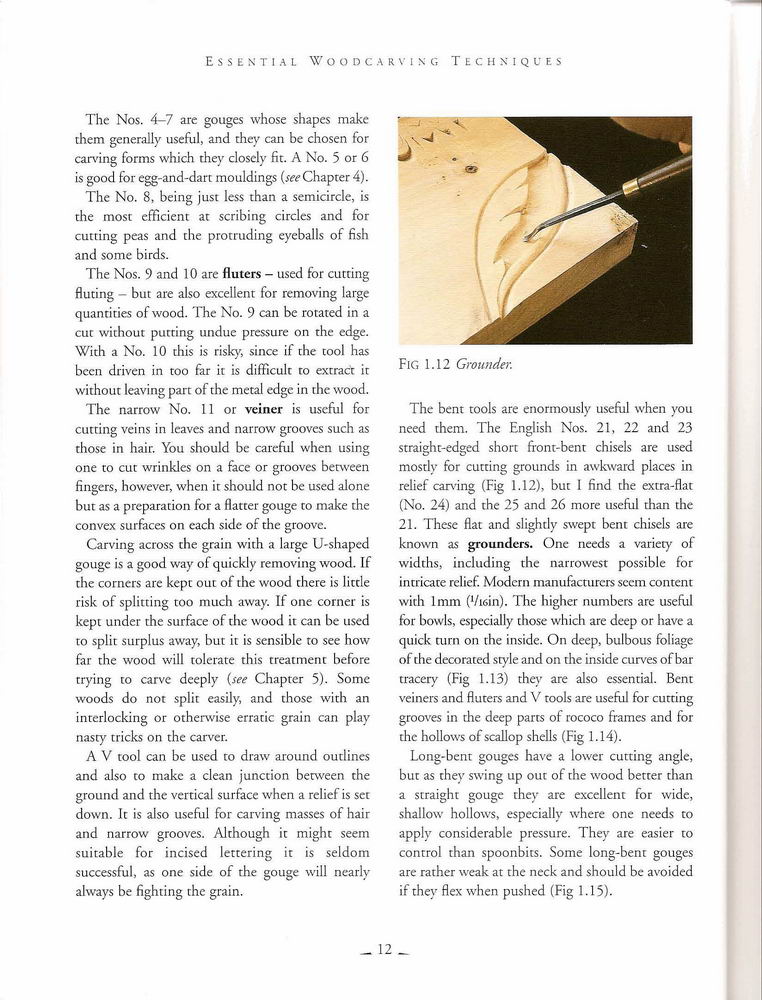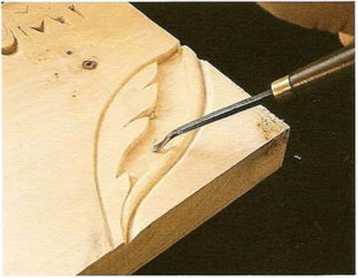essentÊrving°12

E S S E N TI AL W O O D C A R VI X G TECHNIQ U E S
The Nos. 4-7 are gouges whose shapes make them generaUy useful, and chey can be chosen for carving forms which rhey closcly fit. A No. 5 or 6 is good for egg-and-dart mouldings (/<?eChaprer 4).
The No. B, being just less than a semicircle, is the most efficient at scribing circles and for cutting peas and the protruding eyeballs of fish and some birds.
The Nos. 9 and 10 are fluters - used for cutting fluting - but are also excellent for removing large quantities of wood. The No. 9 can be rotated in a cut without putting undue pressure on the edge. With a No. 10 this is risky, sińce if the tool has bccn driven in too far it is difFicult to extract it without leaving part of the metal edge in the wood.
The narrow No. 11 oi veiner is uscful for cutting veins in lcaves and narrow grooves such as those in hair. You should be careful when using one to cut wrinkles on a face or grooves between fingers, however, when it should not be used alone but as a preparation for a flatter gouge to make the convex surfaces on each side of the groovc.
Carving across the grain with a large U-shapcd gouge is a good way of quickly removing wood. If the corncrs are kept out of the wood there is little risk of splitting too much away. If one corner is kept under the surface of the wood it can be used to split surplus away, but it is sensible to see how far the wood will tolerate this treatment before trying to carve deeply (see Chapter 5). Some woods do not split easily, and those with an intcrlocking or otherwise erratic grain can play nasty tricks on the carver.
A V tool can be used to draw around outlines and also to make a clean junction between the ground and the vcrtical surface when a relief is set down. It is also useful for carving masses of hair and narrow grooves. Although it might seem suitable for incised lettering it is seldom successful, as one side of the gouge will nearly always be fighting the grain.

Fig 1.12 Grounder.
The bent tools are enormously uselul when you need them. The English Nos. 21, 22 and 23 straight-edged short front-bent chisels are used mostly for cutting grounds in awkward places in relief carving (Fig 1.12), but I find the extra-flat (No. 24) and the 25 and 26 morÄ™ uscful than the 21. These fiat and slighdy swept bent chisels are known as grounders. One needs a variety of widths, including the narrowest possible for intricate relief. Modern manufacturcrs seem content with lmm O/usin). The higher numbers are useful for bowls, especially those which are deep or have a quick turn on the inside. On deep, bulbous foliage of the decorated style and on the inside curves of bar traccry (Fig 1.13) they are also essential. Bent veiners and fluters and V tools are useful for cutting grooves in the deep parts of rococo frames and for the hollows of scallop shells (Fig 1.14).
Long*bent gouges have a lower cutting angle, but as they swing up out of the wood better than a straight gouge they are excellent for wide, shallow hollows, especially where one needs to apply considerable pressure. They are easier to control than spoonbits. Some long-bent gouges are rather weak at the neck and should be avoided if they flex when pushed (Fig 1.15).
_ 12 _
Wyszukiwarka
Podobne podstrony:
essent?rving?30 Essen ti al Woodcarving Techniques Fig 2.4 A piece of Southern yeUow pine. The dark
essent?rving?66 Essen ti al Woodcarvixg Techniques Fig 5.1 Oak leafstudies by a student (Howard Spie
562 FROM THE AL PS TO THE BALTIC Thus this whole area received Western European culture and was conn
562 FROM THE AL PS TO THE BALTIC Thus this whole area received Western European culture and was conn
00104 U22672e84810718d615778de2b5b475 103 The OCAP benefits are experienced by production superviso
The Proceedings are composed of nine parts (See Contents). The introductory paper by Funch et a
Section B. Technical requirements 1. The following are required in order to partic
SL274094 ,-r dC&U - > Vi IlT ^ M ^ a cl t Ti -.»• .» -/Al ■J:CC ^Hr r M ^U Q“)
58 (289) 3.6.1A. Non-specific techniÄ…ue to increase dorsal flexion with rotation and later-al flexio
48 (389) 3 THE ELBOW 3.1 THERAPY GUIDE The muscles which may restrict movement at the elbow are list
essent?rving?18 Essen tul Woodcarning Techniques Fig 1.29 A bench holdfast in use. Fig 1.28 A univer
essent?rving?34 Essen tial Woodcarying Techniques softwoods are evergreen and hardwoods are dcciduou
essent?rving?50 Essen tial W o o d c a r vin g Techniques Fig 3.11 Making the stab aa at too shallow
essent?rving?68 E S 5E NTI A L W O O D C A R VIN G TECHNIQLES Fig 5.6 The gouge can removeplenty of
essent?rving?72 Essen tial Woodcarving Techniques although the temptarion ro use a router co set clo
więcej podobnych podstron